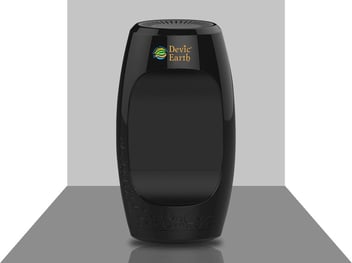Why Smog Towers may not Solve the Problem of Air Pollution
A huge tower spiraling into the sky is certainly a visual reassurance. It stands tall as a symbol of our grand endeavors to fight smog air pollution and restore public consciousness. The question is: how sustainable are smog towers?
How Smog Tower Works - Smog Tower Working?
So, what is a smog tower? A smog tower working is like an indoor air purifier but is bigger and functions on a larger scale. These air purifier towers in India work on HEPA filtration or air ionization technology to remove PM 2.5 particles from the air. The impure air passes through layers of filters, purifying and releasing cleaner air.
Are smog towers as promising as they are made out to be?
In recent times, we have towering many air purifier towers in India amidst much appreciation and intrigue. Recently, a smog tower was installed in the Lajpat Nagar area in Delhi by Gautam Gambhir Organization.
According to a statement from the office, the 20-feet-tall air purifier in Delhi can treat and deliver 6 lakh cubic meters of clean air every day but the impact is limited to a 50-meter radius.
The support of celebrities like Gautam Gambhir has added to the glamor and promise of the anti-smog tower. While it is certainly appreciable that India has started installing home-produced smog towers, their efficacy and sustainability have been strongly questioned in recent times.
1. Success is yet to be seen to scale this technology
One of the first points of contention is their very high cost of installation. These massive structures take both immense time and money. The estimated cost of one Delhi smog tower set up in Connaught Place was ₹20 crores.
Smog towers can range in height from 12 to 100 meters. Evidently, setting one up would take an exhaustive amount of time and labor. Imagine how much expense would be incurred by installing a mere ten towers in a city.
The Delhi government itself has been quick to add that tangible results will have to be seen before they plan to install more smog towers in Delhi - in fact all across the city.
2. High costs of land and equipment reduce feasibility and viability
Dr. Srikanth Sola, CEO of Devic Earth, was asked to review a plan for setting up an anti-smog tower in the periphery of Delhi. The cost of one hectare of land required for setting up the tower was ₹20 crore, and the price of air purifier in Delhi itself would cost another 20 crores. Such high costs certainly make technological solutions not viable to set up and implement.
3. High maintenance despite huge CAPEX
India’s tallest Air Purifier
Another of the questions raised pertains to the maintenance of smog towers. Depending on the technology used, a single smog tower may require several HEPA filters, or fabric/metal filters, which are most difficult to recycle. Maintaining a smog tower costs at least ₹ 30,000-40,000 per month. Since the filters are not recyclable, the cost of maintaining a smog tower would be very high. Consider also how much they would contribute to landfills, in the long term. It also remains to be seen exactly how efficient smog towers are.
4. Strong pollutants still present in the air
A recent experiment done in Delhi by the Help Delhi Breathe initiative, among other organizations, demonstrated a pair of synthetic cloth-based “lungs” in a public space.
Initially pure white, the display turned grey in less than 24 hours and blackened in a few days. This is a gruesome reminder of how quickly polluted air impacts health and leads us to wonder if systems like how smog towers can work since the level of pollution is so high.
5. Limited coverage area, low efficiency, and high cost
The shortfall with most outdoor air purification systems is a limited area of coverage, limited efficacy, and high cost. Recall the WAYU air purification systems installed at traffic points in Delhi, which ultimately came to be used as garbage bins. For any pollution control technology that requires constant maintenance, the lifelong process of having to follow up will increase the chances of it being neglected altogether. Especially in the absence of a functional regulatory body, these expensive installations become junk, pitifully draining taxpayers’ money.
Observations:
According to Council on Energy, Environment, and Water (CEEW), around 2.7 million similar smog towers are required to bring ambient air pollution levels down in Delhi, which will cost up to 1700 billion rupees of capital investment which amounts to 2.5 times Delhi’s state budget expenditure in the financial year 2019-20.
The council on Energy, Environment, and Water (CEEW) states that there is no scientific evidence of the effectiveness of anti-smog towers at a city level. Similar observations were stated through an experiment conducted by China, and it was concluded that there is little to no significant evidence that smog towers can address ambient air pollution at scale.
Ways to address ambient air pollution:
- Enforcing emission standards of power plants to close down the risk, meeting the prescribed levels of PM concentration.
- Improving public transport through aggressive ruling out of buses to reduce public transport dependence.
- Strengthening of air pollution monitoring standards by air pollution control authorities.
- By becoming aware and recognizing the crisis we are facing at the moment.
The Solution
Devic Earth believes that sustainable and affordable air pollution control equipment needs to be made available to the general public. The most important step for effective air pollution control would be to reduce pollution at the source. It is necessary to use commercial air cleaners like Pure Skies, only when traditional methods of pollution control are insufficient. When vetted for efficacy and cost-effectiveness, technology can go a long way in curbing pollution. One must consider the long-term efficacy of any solution to the environmental problem, and work towards satisfying all stakeholders: the human community, and our planet.
How does Pure Skies work?
Pure Skies by Devic Earth is a pulsed radio wave-based air pollution control technology. Pulsed radio waves are spread across the area to be covered, via base stations and extender units of Pure Skies. Our technology accelerates the natural process of the clearance of particulate matter (pm) and the formation of dry deposition. Our technology is tested and has third-party certification for safety. Our air pollution control device operates in the normal Wi-Fi signal range and is completely safe for humans, flora, and fauna.
Pure Skies Vs Other Technologies:
'Pure Skies' is a scientific first Air Pollution control technology that improves air quality by 33-90% over large areas at the lowest cost per unit area. Our technology targets and combats harmful particulate pollutants such as PM10 and PM2.5. Our air pollution control device does not require passing air through several filters to deliver clean air. Whereas other technologies such as Baghouses, Electrostatic precipitators, smog towers, etc. come with a high cost and are unsuccessful in capturing fugitives and particulate matter. Pure Skies comes with the advantage of zero maintenance. Only annual routine maintenance of air quality monitors is required.
Know more about our breakthrough Pulsed Radio Wave-based Clean Air Technology: Pure Skies by Devic Earth.

.svg)
.webp?width=1080&height=1080&name=Free%20Case%20Study%20Steel%20Plant%20(1).webp)







Post Comments